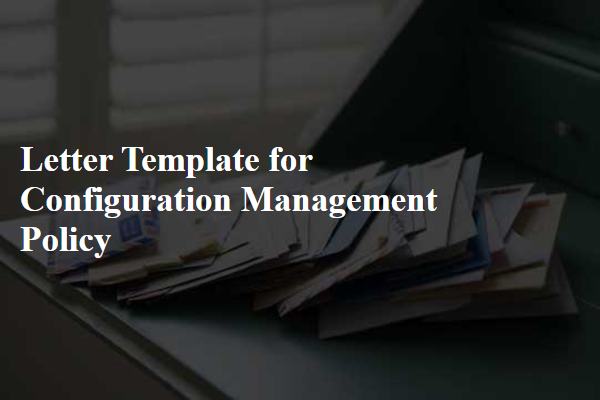Are you looking to streamline your organization's configuration management processes? A well-crafted Configuration Management Policy can be the key to ensuring consistency, reliability, and efficiency in managing your IT assets. This article will guide you through creating the perfect letter template that aligns with best practices and regulatory requirements. So, let's dive in and explore how you can set the foundation for a robust configuration management framework!

Scope and Objectives
Configuration management policy aims to provide a structured approach to managing system configurations within various IT environments. The scope includes all critical assets, such as servers, databases, applications, and network devices, ensuring consistency and control throughout their lifecycle. Objectives focus on maintaining integrity by tracking changes, ensuring compliance with standards such as ISO 20000 and ITIL, minimizing risks related to unauthorized configuration changes, and facilitating efficient disaster recovery processes. Regular audits and reviews will enhance visibility and accountability, ensuring that all configuration items, identified by unique identifiers and version control, are aligned with organizational goals.
Roles and Responsibilities
Configuration management policy outlines specific roles and responsibilities essential for maintaining the integrity and reliability of systems throughout their lifecycle. Each role has defined duties; the Configuration Manager oversees the entire process, ensuring compliance with industry standards, such as ISO 20000, and regulatory requirements, including SOX, while also managing change requests that arise from stakeholders. Team members, referred to as Configuration Analysts, perform regular audits to verify asset configurations against recorded baselines; they work with configuration items (CIs), which include software, hardware, and documentation, to maintain an accurate Configuration Management Database (CMDB). Additionally, the Change Advisory Board (CAB), consisting of cross-functional representatives, evaluates proposed changes' potential impact on service quality, ensuring that any configuration alterations lead to improved system performance and compliance with the organization's operational goals.
Configuration Identification Process
Configuration identification processes are essential for effective configuration management in software development and IT environments. This process involves defining and documenting the characteristics of a software system, including hardware, software, and documentation components. Each configuration item (CI), such as source code files, system images, or databases, is assigned a unique identifier to facilitate tracking and control. The identification process also includes versioning information, detailing revisions and updates, which is crucial for maintaining consistency and reliability. Additionally, the process involves gathering requirements, categorizing components, and establishing baselines to ensure all stakeholders have a clear understanding of the system's configuration. Through rigorous configuration identification, organizations can enhance traceability, improve communication among teams, and minimize the risks associated with changes and discrepancies in system components.
Change Control Procedures
Configuration management policy outlines the essential change control procedures necessary for maintaining the integrity of software and hardware systems. Change control procedures involve a systematic approach to managing alterations, which includes documenting requests for changes, assessing potential impacts, and obtaining necessary approvals from stakeholders. The change request documentation should include critical details such as the nature of the change, associated risks, and implementation timelines. Additionally, testing environments must be prepared to validate changes before deployment, ensuring that existing operations remain unaffected during transitions. Communication channels should be established to inform relevant personnel about upcoming changes, including training sessions if required. Following successful implementation, all changes must be officially recorded in the configuration management database (CMDB) for future reference and auditing purposes. Consistent adherence to these change control procedures ensures the stability and reliability of system configurations across the organization.
Auditing and Review Protocols
Configuration management policies play a pivotal role in maintaining system integrity within organizations. Auditing protocols, like those outlined in the ISO/IEC 27001 standards, ensure that configurations are aligned with security frameworks. Regular reviews, typically scheduled bi-annually, foster ongoing compliance and identify potential deviations from established configurations. Documentation of these audits, maintained for a minimum of three years, supports accountability and traceability across IT assets. Tools like Ansible or Puppet automate the process, ensuring consistent configurations across server farms located in data centers such as Amazon Web Services in Virginia. Adjustments based on audit findings lead to a refined configuration management strategy, enhancing overall organizational security posture and operational efficiency.













Comments